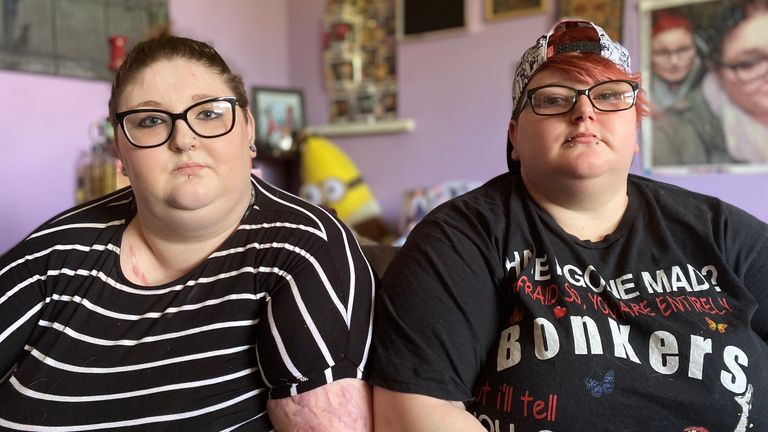[ad_1]
Katie Hill walks into her small kitchen carrying a large cardboard box. Inside are all the drugs she needs to stay alive.
There is a lot of medicine. Katie explains what each drug does and how it helps her to cope with each of her health conditions.
The two most significant ones are her Brittle Asthma and non-epileptic seizures. Last month, Katie needed urgent hospital treatment after a seizure.
She told me: “I was very, very short of breath. White and clammy. And it was terrifying. It’s when you can’t breathe properly, it feels like none of your breath will come out or in at all. It makes you extremely wobbly. You don’t feel like you’re in your own body. It’s very scary.”
Katie and her partner Jamie called for an ambulance. After waiting for an hour and not knowing how long one would take, Jamie called her father-in-law Mark to drive them to the hospital.
She describes the scene when they got to the hospital: “When we arrived the car park was full of cars, police cars and vans.”
She says: “There were ambulances backed up in three rows of four vehicles, all with patients inside. That was very overwhelming, that many people there, you start to panic as well, if you don’t get seen soon enough.”
Once inside the emergency department of Swindon’s Great Western Hospital, Katie braced herself for another long wait. She said the scene was chaotic. Her father Mark said it looked “like a battle zone”.
“You had people sitting everywhere, there was no space between them. You had people that were drunk, people shouting. The corridors were full of patients on trolleys. The ambulances were queued up outside with patients.”
Kate was triaged after an hour and the doctor warned her that the hospital was full.
“I asked them ‘how long is it going to be, waiting in A&E’ and he was very truthful. He said ‘look I don’t know. It will be the late hours of the morning. There are no beds. There is no space on any ward to take you.”
Read more:
Record 6.5 million people waiting for routine NHS hospital treatment in England
More than 1,000 people waiting longer than 12 hours in A&E every day, figures reveal
Katie waited for eight or nine hours lying on a trolley in an emergency bay until it was decided it would be safe for her to return and continue her treatment at home.
The experience has left Katie and her partner Jamie traumatised. Jamie waited with Katie through the night and had to sit on the floor because there were no chairs available.
Jamie said: “I know we’re still in the pandemic and it has been two years and everyone is trying to live life as normal as they can but the NHS is struggling and it is worrying because people are going to lose lives because of it.”
The Great Western Hospitals NHS Foundation Trust apologised to Katie for her long wait to be treated and said that can be the case when they are busy as they treat patients in order of clinical urgency.
[ad_2]



